Nuclear energy output slows as climate warms
DOI: 10.1063/PT.3.2414
Despite emission reductions by the US, Russia, and some other nations, worldwide anthropogenic greenhouse gas emissions accelerated at an annual rate of 2.2% from 2000 to 2010 and reached a record high of 49 billion metric tons of carbon dioxide equivalent in 2010, according to the fifth assessment of the Intergovernmental Panel on Climate Change (IPCC). By comparison, emissions grew at an annual average rate of 1.6% during 1970–2000. Carbon dioxide equivalent is a unit of measurement used to convert the heat-trapping effects of other greenhouse gases such as methane.
A separate report released on 6 May by the US Global Change Research Program (USGCRP) says that the effects of climate change are already being felt in the US. Effects include longer summers, rising tides, more prolonged heat waves, heavier downpours, and regional changes in the varieties of plant and bird species.
Without any further policy actions to control emissions of greenhouse gases, the world is likely to see a rise of up to 4.8 °C in the average global temperatures by the end of the century, according to the IPCC. That is more than double the 2 °C rise from preindustrial-era temperatures that scientists have estimated to be the upper limit if the worst impacts of climate change are to be averted.
The USGCRP assessment, which was based on the results from 16 climate models, predicts that if emissions from fossil-fuel combustion are left unchecked, temperatures could increase by up to 5.6 °C by the end of the century. Even with substantial reductions in CO2 emissions, the temperature could rise as much as 2.8 °C by 2100, says the report.
Viewed against that backdrop, the recent closures of five US nuclear reactors and the threat of additional plant retirements caused by economic pressures on an aging nuclear fleet jeopardize the Obama administration’s commitment to reduce US greenhouse gas emissions to 17% below 2005 levels by 2020.
The US is the world’s second largest emitter of greenhouse gases, behind China. The IPCC estimates that global emissions will need to be slashed by up to 70% by midcentury in order to remain below the 2 °C threshold.
Worldwide, energy production is the largest source of manmade greenhouse gases; it accounts for 35% of total emissions. Also the fastest-growing emitter, energy supply contributed 47% of the increase in emissions in the 2000–10 period, said the IPCC assessment, the third installment of which was released in mid-April.
Low-carbon sources—nuclear, renewables, and fossil fuels coupled with carbon capture and storage—must grow from their current 30% share to 80% of world electricity production by 2050, the IPCC says. But nuclear’s global share has been declining, from 17% in 1993 to 11% currently, according to the International Atomic Energy Agency.
Off the table
“If you read the IPCC reports, they are clear that maybe we are out of time, but certainly we have little time” to reduce greenhouse gases in earnest, said Carol Browner, former Environmental Protection Agency administrator, at a Washington, DC, conference hosted by the Center for Climate and Energy Solutions (C2ES) on 28 April. “I used to be antinuclear until after I left EPA and started to realize the single biggest problem the world needs to address is climate change, and that you can’t take off the table a technology that is basically carbon free,” Browner said.
Nuclear reactors provide 60% of the nation’s current supply of zero-emissions energy, more than four times the amount generated by wind and solar combined, according to the Energy Information Administration (EIA) of the Department of Energy. About one-fifth of all US electricity is nuclear generated. Since 2005, US CO2 emissions from the electric-power sector have fallen by 15%, largely due to a shift from coal to natural gas, the economic recession, and increases in energy efficiency and wind generation, according to C2ES. But the EIA forecasts that in the absence of new policies, the proportion of fossil-fuel and zero-carbon energy sources in the US will remain relatively stable through 2040.
“The bottom line is that if we keep shutting down nuclear power plants, it will be that much tougher to meet even our near-term climate goals,” said Eileen Claussen, C2ES president. Since late 2012 four US power companies have unexpectedly announced the retirement of five reactors, representing 4.2% of the country’s total nuclear generating capacity. The owners of two of those plants, Kewaunee in Wisconsin and Vermont Yankee, blamed the closures on low natural gas prices and other economic issues. The other closures, of Crystal River in Florida and the two reactors at San Onofre, California, were attributed to maintenance issues, specifically problems related to replacing their steam generators, according to C2ES. Peter Lyons, DOE assistant secretary for nuclear energy, said that mechanical fixes were available for those three units, and the owners likely would have paid for them in a more favorable economic environment.

The Vermont Yankee nuclear power plant is one of five US commercial nuclear reactors whose owners have recently announced closures.
ENTERGY

The EIA, in its Annual Energy Outlook 2014, forecasts another 6 GW of US nuclear generating capacity—roughly six reactors—will be shut down by 2019, as higher-cost units face continued economic challenges. Five reactors are currently under construction in the US, but the EIA forecasts that beyond those five, no additional nuclear plants will be built through 2030.
More about the Authors
David Kramer. dkramer@aip.org




